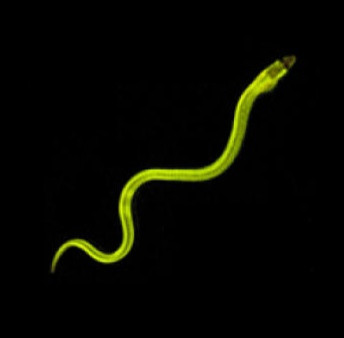First Fluorescent Protein Discovered In Vertebrates, Japanese Eel Could Hold Key For Revolutionary Liver Test [PHOTO]

The freshwater Japanese eel known as unagi may be a tasty sushi ingredient, but it also contains the first fluorescent protein identified in a vertebrate. The protein's discovery not only explains how eels glow in the dark but also could be the key to a new clinical test on liver function in humans, according to a report published in Cell on Thursday.
“I don't think anyone would have thought that eels would have such a bright fluorescent protein,” Robert Campbell, a protein engineer at the University of Alberta in Edmonton, Canada, told the Scientific American. The protein, named UnaG, is completely different from other proteins, he says. “There's not anything you can point to that's the same.”
According to researchers from the RIKEN Brain Science Institute in Tokyo, the fluorescent protein could help identify bilirubin, a yellowish fluid made by the liver that acts as a blood marker for liver function. High amounts of bilirubin in red blood cells can indicate the presence of jaundice and hemolysis, the breakdown of red blood cells.
Dr. Atsushi Miyawaki, Dr. Akiko Kumagai and their research team discovered that UnaG uses bilirubin to emit its powerful green light. The team developed a new clinical analysis surrounding this discovery that could become the new global standard when testing for liver function.
Campbell points to another unique quality of the fluorescent protein: its ability to glow brightly even when oxygen levels are low. This could help make anaerobic areas visible inside cancerous tumors, he says.
Fluorescent proteins have long been a tool for cell biologists. In 2008 the Nobel Prize for Chemistry was won by a group of scientists who identified a green fluorescent protein, GFP, that makes jellyfish glow, Nature reports. The protein can be used to tag other proteins or to track how genes are expressed. Until recently, fluorescent proteins were believed to exist in invertebrates like microbes, jellyfish and coral.
Miyawaki was led to the discovery of UnaG by a 2009 report by food chemists Seiichi Hayashi and Yoshifumi Toda. The pair found eel muscle tissue glowed green when they shone blue light on it, and they managed to isolate the proteins responsible. Miyawaki took the discovery one step further by identifying the gene that codes for the molecule and giving the protein a name, the Scientific American reports.
Scientists say the fluorescent protein helps Japanese freshwater eels when they travel from rivers out to sea to spawn; UnaG helps their muscle function to make the long-distance journey from river to ocean. But global warming has threatened the Unagi eels with extinction; the discovery could spark new conservation efforts.
With new light shed on UnaG, Dr. Atsushi Miyawaki says the protein could be the “foothold” for lesser-known aspects of human health such as bilirubin metabolism and muscle physiology during endurance exercise.
"Before the discovery of UnaG, I couldn't imagine that basic science could have such a direct impact on human health. From a simple eel, we found a new path to the clinic," he says.
© Copyright IBTimes 2025. All rights reserved.






















